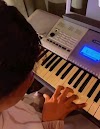# Piano Tutorial: Correct Finger Placement for Triad Chords
#### Understanding Triad Chords
Triad chords are the building blocks of harmony in music. They are formed by stacking thirds on top of each other, resulting in various chord qualities such as major, minor, diminished, and augmented.
#### Basic Triad Chord Structures
1. **Major Triad**: Consists of a root (1st), major third (3rd), and perfect fifth (5th).
2. **Minor Triad**: Consists of a root (1st), minor third (♭3rd), and perfect fifth (5th).
3. **Diminished Triad**: Consists of a root (1st), minor third (♭3rd), and diminished fifth (♭5th).
4. **Augmented Triad**: Consists of a root (1st), major third (3rd), and augmented fifth (#5th).
#### Finger Placement for Triad Chords
**Right Hand Finger Placement**:
- **Root Position Triad (C Major)**:
- Thumb (1) on C (root)
- Middle Finger (3) on E (major third)
- Pinky Finger (5) on G (perfect fifth)
- **First Inversion Triad (E Minor)**:
- Thumb (1) on E (root)
- Index Finger (2) on G (minor third)
- Pinky Finger (5) on B (perfect fifth)
- **Second Inversion Triad (G Major)**:
- Thumb (1) on G (root)
- Middle Finger (3) on B (major third)
- Pinky Finger (5) on D (perfect fifth)
**Left Hand Finger Placement**:
Follow the same finger placement principles as the right hand but in reverse order.
#### Practical Examples
Let's apply correct finger placement to play the following triad chords:
1. **C Major Triad (Root Position)**:
- Right Hand: C-E-G (1-3-5)
- Left Hand: C-E-G (5-3-1)
2. **E Minor Triad (First Inversion)**:
- Right Hand: E-G-B (1-3-5)
- Left Hand: E-G-B (5-3-1)
3. **G Major Triad (Second Inversion)**:
- Right Hand: G-B-D (1-3-5)
- Left Hand: G-B-D (5-3-1)
#### Practice Tips
1. **Slow Practice**: Start slowly to ensure accuracy and build muscle memory.
2. **Hand Independence**: Practice each hand separately before playing together to focus on finger placement.
3. **Use a Metronome**: Practice with a metronome to maintain a steady tempo and improve rhythm.
#### Additional Exercises
1. **Triad Progressions**: Practice common chord progressions using triad chords in different inversions, such as I-IV-V in various keys.
2**Chord Voicings**: Experiment with different voicings and spacings of triad chords to create richer harmonic textures.
By mastering correct finger placement for triad chords and incorporating them into your practice routine, you'll develop greater fluency and confidence in your piano playing. Don't forget to share.










0 Comments